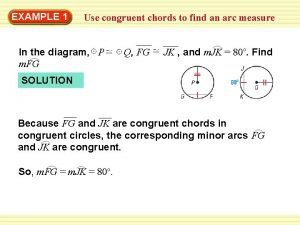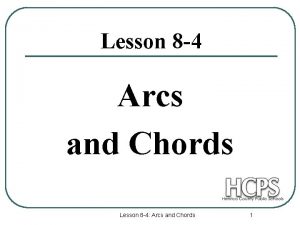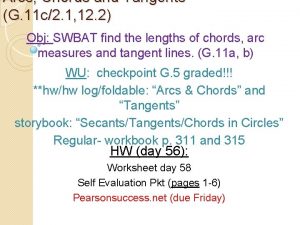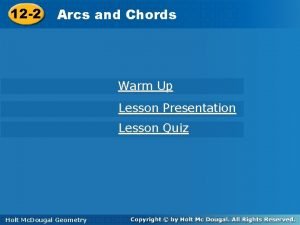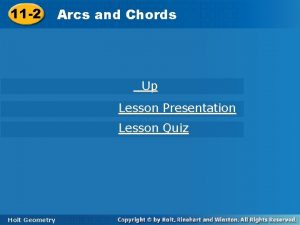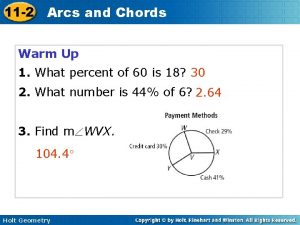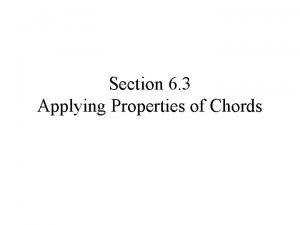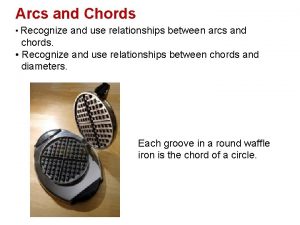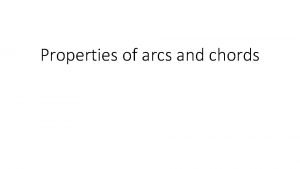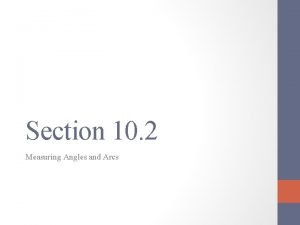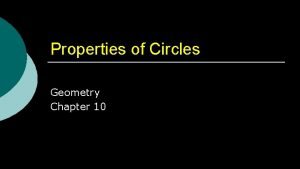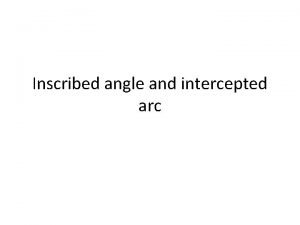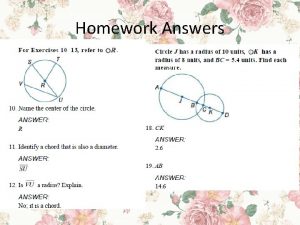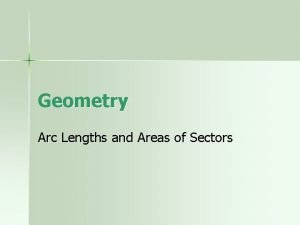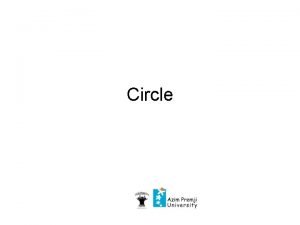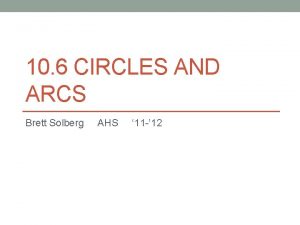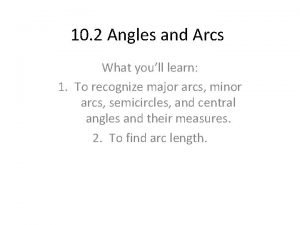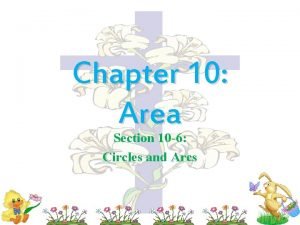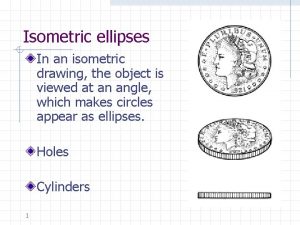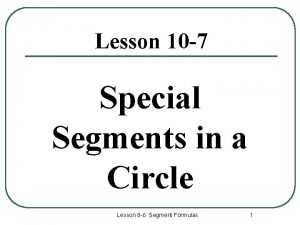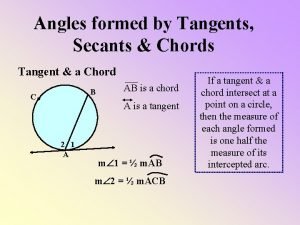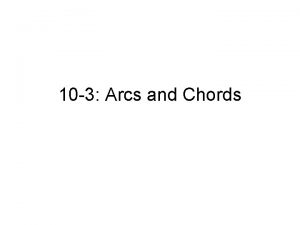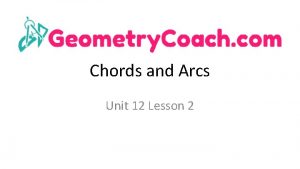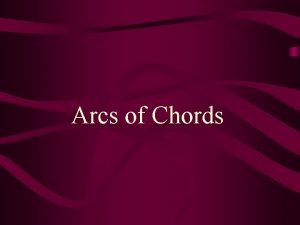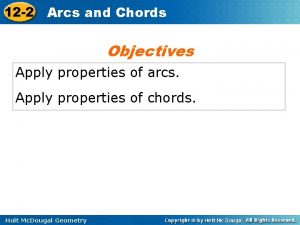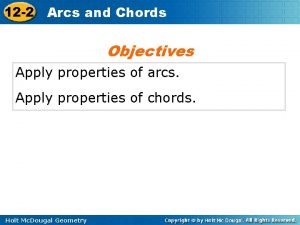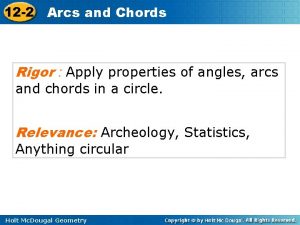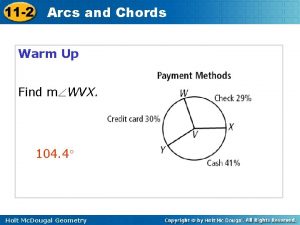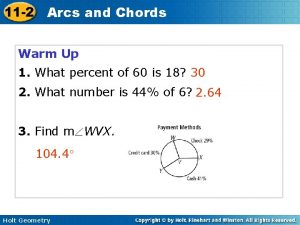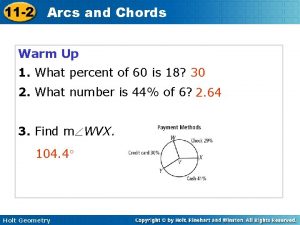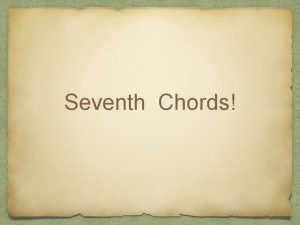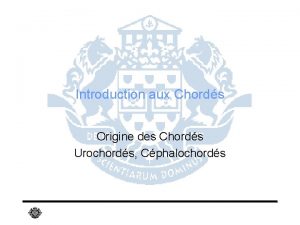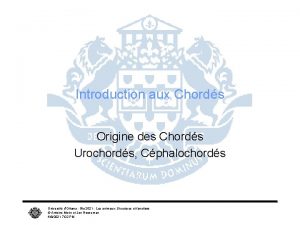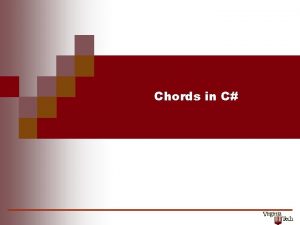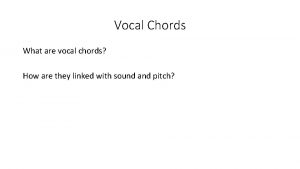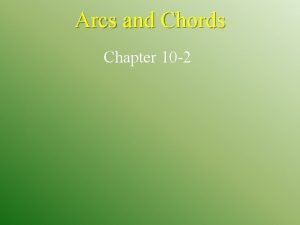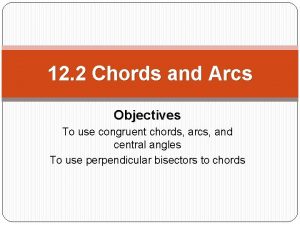Properties of arcs and chords Warm Up 1


























- Slides: 26

Properties of arcs and chords

Warm Up 1. What percent of 60 is 18? 30 2. What number is 44% of 6? 2. 64 3. Find m WVX. 104. 4

Objectives Apply properties of arcs. Apply properties of chords.

Vocabulary central angle arc minor arc major arc semicircle adjacent arcs congruent arcs

A central angle is an angle whose vertex is the center of a circle. An arc is an unbroken part of a circle consisting of two points called the endpoints and all the points on the circle between them.


Writing Math Minor arcs may be named by two points. Major arcs and semicircles must be named by three points.

Example 1: Data Application The circle graph shows the types of grass planted in the yards of one neighborhood. Find m. KLF = 360° – m KJF = 0. 35(360 ) = 126 m. KLF = 360° – 126° = 234

Check It Out! Example 1 Use the graph to find each of the following. a. m FMC = 0. 30(360 ) = 108 Central is 30% of the . c. m EMD = 0. 10(360 ) b. m. AHB = 360° – m AMB m AHB = 360° – 0. 25(360 ) = 36 = 270 Central is 10% of the .

Adjacent arcs are arcs of the same circle that intersect at exactly one point. RS and ST are adjacent arcs.

Example 2: Using the Arc Addition Postulate Find m. BD. m. BC = 97. 4 Vert. s Thm. m CFD = 180 – (97. 4 + 52 ) = 30. 6 ∆ Sum Thm. m. CD = 30. 6 m. BD = m. BC + m. CD = 97. 4 + 30. 6 = 128 m CFD = 30. 6 Arc Add. Post. Substitute. Simplify.

Check It Out! Example 2 a Find each measure. m. JKL m KPL = 180° – (40 + 25)° m. KL = 115° m. JKL = m. JK + m. KL = 25° + 115° = 140° Arc Add. Post. Substitute. Simplify.

Check It Out! Example 2 b Find each measure. m. LJN = 360° – (40 + 25)° = 295°

Within a circle or congruent circles, congruent arcs are two arcs that have the same measure. In the figure ST UV.


Example 3 A: Applying Congruent Angles, Arcs, and Chords TV WS. Find m. WS. TV WS m. TV = m. WS 9 n – 11 = 7 n + 11 chords have arcs. Def. of arcs Substitute the given measures. Subtract 7 n and add 11 to both sides. 2 n = 22 Divide both sides by 2. n = 11 m. WS = 7(11) + 11 Substitute 11 for n. Simplify. = 88°

Example 3 B: Applying Congruent Angles, Arcs, and Chords C J, and m GCD m NJM. Find NM. GD NM GCD NJM GD NM arcs have chords. GD = NM Def. of chords

Example 3 B Continued C J, and m GCD m NJM. Find NM. 14 t – 26 = 5 t + 1 9 t = 27 t=3 NM = 5(3) + 1 = 16 Substitute the given measures. Subtract 5 t and add 26 to both sides. Divide both sides by 9. Substitute 3 for t. Simplify.

Check It Out! Example 3 a PT bisects RPS. Find RT. RPT SPT m. RT m. TS RT = TS 6 x = 20 – 4 x 10 x = 20 x=2 RT = 6(2) RT = 12 Add 4 x to both sides. Divide both sides by 10. Substitute 2 for x. Simplify.

Check It Out! Example 3 b Find each measure. A B, and CD EF. Find m. CD. chords have arcs. m. CD = m. EF 25 y = (30 y – 20) Substitute. Subtract 25 y from both sides. Add 20 20 = 5 y to both sides. Divide both sides by 5. 4=y Substitute 4 for y. CD = 25(4) m. CD = 100 Simplify.


Example 4: Using Radii and Chords Find NP. Step 1 Draw radius RN. RN = 17 Radii of a are . Step 2 Use the Pythagorean Theorem. SN 2 + RS 2 = RN 2 SN 2 + 82 = 172 SN 2 = 225 SN = 15 Substitute 8 for RS and 17 for RN. Subtract 82 from both sides. Take the square root of both sides. Step 3 Find NP. NP = 2(15) = 30 RM NP , so RM bisects NP.

Check It Out! Example 4 Find QR to the nearest tenth. Step 1 Draw radius PQ. PQ = 20 Radii of a are . Step 2 Use the Pythagorean Theorem. TQ 2 + PT 2 = PQ 2 Substitute 10 for PT and 20 for PQ. TQ 2 + 102 = 202 Subtract 102 from both sides. TQ 2 = 300 Take the square root of both sides. TQ 17. 3 Step 3 Find QR. QR = 2(17. 3) = 34. 6 PS QR , so PS bisects QR.

Lesson Quiz: Part I 1. The circle graph shows the types of cuisine available in a city. Find m. TRQ. 158. 4

Lesson Quiz: Part II Find each measure. 2. NGH 3. HL 139 21

Lesson Quiz: Part III 4. T U, and AC = 47. 2. Find PL to the nearest tenth. 12. 9
 Homework 4 congruent chords and arcs
Homework 4 congruent chords and arcs 10-3 arcs and chords
10-3 arcs and chords Lesson 8 arcs and chords
Lesson 8 arcs and chords 10-3 arcs and chords
10-3 arcs and chords 9-3 arcs and chords worksheet answers
9-3 arcs and chords worksheet answers Worksheet arcs and chords 12-2 answer key
Worksheet arcs and chords 12-2 answer key Practice 11-2 chords and arcs answer key
Practice 11-2 chords and arcs answer key 11-2 arcs and chords worksheet answers
11-2 arcs and chords worksheet answers 10-3 practice arcs and chords
10-3 practice arcs and chords Arcs and chords
Arcs and chords Find each measure
Find each measure The distance along an arc measured in linear units
The distance along an arc measured in linear units Geometry unit 10 circles
Geometry unit 10 circles What is an intercepted arc
What is an intercepted arc 10-2 measuring angles and arcs answers
10-2 measuring angles and arcs answers Arc length and sector area khan academy
Arc length and sector area khan academy Minor segment of a circle
Minor segment of a circle Mior arc
Mior arc 10-6 circles and arcs
10-6 circles and arcs 10-2 measuring angles and arcs
10-2 measuring angles and arcs Circle vocabulary
Circle vocabulary Vertex
Vertex Patterns are made using straight lines and arcs
Patterns are made using straight lines and arcs Ellipse isometric drawing
Ellipse isometric drawing Arcs and sparks
Arcs and sparks Special segment in a circle
Special segment in a circle Angles formed by chords tangents secants
Angles formed by chords tangents secants
